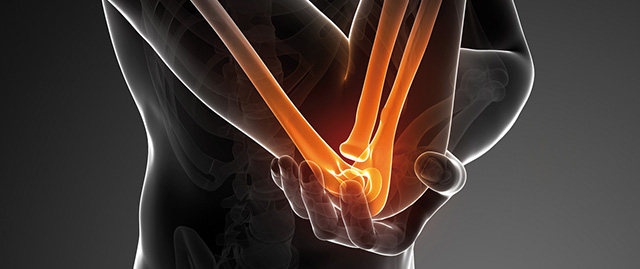Individual treatment adapted for each patient’s needs is not easy to come by. But here at ORTHOmedic, that’s exactly what you’ll find.

Elbow
The elbow is the most robust joint in the human body after the knee. It is possible to build up a great deal of strength in the arm thanks to the strong ligaments and muscles spanning the elbow joint. However, the elbow is the second most likely joint in the body to become dislocated and is possibly the joint that is most frequently overloaded with strain.
Overstretching when lifting heavy objects, abrupt deceleration that may occur when practising ball sports or strain on one side as a result of repetitive movements can all put considerable strain on the elbow joint. Many ailments of the knee can be remedied with physiotherapy and medication. Here at ORTHOmedic, we can provide you with this care, and our experts are also on hand should you require surgery.
On this page you will find an overview of the most commonly occurring problems that affect the elbow. Many surgical procedures on the elbow can be carried out via arthroscopy. ORTHOmedic is specialised in this minimally invasive procedure. Your expert for elbow problems is Professor Schofer.
Tennis arm / elbow and golfer’s elbow
You’ve probably heard of tennis elbow before. From a medical perspective, it’s also one of the most common problems, but luckily, it’s also relatively simple to treat. First of all, it’s important to protect the tendons in the muscle system in the forearm that are under strain. Shockwave therapy, medication and physiotherapy are all possible methods of support. Operations are rarely necessary. We also treat the less common equivalent of tennis elbow that occurs on the inner side of the joint known as golfer’s elbow.
Loose bodies in the hip joint
These are tiny fragments of bone or cartilage, which usually come loose as a result of excess strain. In the same way that sand damages a gearbox, these fragments grind the joint down and can cause considerable damage, e.g. arthrosis. A typical symptom of loose bodies in the elbow joint is a painful grinding sensation, not dissimilar sand in a gearbox. Loose bodies can be detected and removed under an arthroscopy.
Osteonecroses (e.g. osteochondritis dissecans/Panner disease)
Early diagnosis of this painful disease is extremely important. Osteonecrosis begins as a circulatory disorder in the bones of the upper arm, which first affects the cartilage and then progresses to the bone. Early detection can prevent permanent damage to the elbow caused by cartilage damage. If permanent damage has already occurred, cartilage therapy or transplantation may be required. These procedures on the elbow can be carried out via arthroscopy. In severe cases, an endoprosthesis may be necessary.
Cubital tunnel syndrome (sulcus ulnaris syndrome)
Cubital tunnel syndrome refers to long-term pain in what is commonly known as the funny bone. Although the ‘funny bone’ doesn’t actually exist, the sensation occurs in a nerve in this area which is largely unprotected and therefore susceptible to injuries and chronic irritation. A minimally invasive surgical procedure can give the nerve more space, eliminating the source of the pain.
Arthrosis
As with all joints, premature wear can affect the elbow. Accidents and injuries to the elbow are common causes, though age-related arthrosis is also widespread. If diagnosed early enough, arthrosis can be treated with physiotherapy and medication. If these methods of treatment are not successful, there are various procedures to preserve the joints that can be carried out via an arthroscopy. In advanced cases, an endoprosthesis is often the only effective method of treatment

